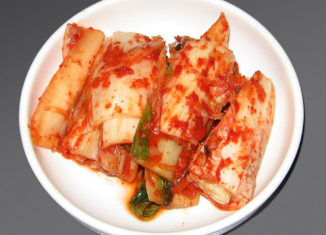
Kimchi, a staple in Korean cuisine, is a traditional side dish made from salted and fermented vegetables, most commonly napa cabbage and Korean radishes, with a variety of seasonings including chili powder, scallions, garlic, ginger, and jeotgal (salted seafood). There are hundreds of varieties of kimchi made with different vegetables as the main ingredients. In traditional preparations, kimchi was stored underground in jars to keep cool, and unfrozen during the winter months With the rise of technology, kimchi refrigerators are more commonly used to make kimchi.
Is is mainly served as a side dish with every meal, but also can be served as a main dish.
Variations of Kimchi :
- baechu-kimchi (배추김치) spicy napa cabbage kimchi, made from whole cabbage leaves
- baechu-geotjeori (배추겉절이) unfermented napa cabbage kimchi
- bossam-kimchi (보쌈김치) wrapped kimchi
- baek-kimchi (백김치) white kimchi, made without chili pepper
- dongchimi (동치미) a non-spicy watery kimchi
- nabak kimchi (나박김치) a mildly spicy watery kimchi
- chonggak-kimchi (총각김치) cubed chonggak “ponytail” radish, a popular spicy kimchi
- kkakdugi (깍두기) spicy cubed Korean radish strongly-scented kimchi containing fermented shrimp
- oi-sobagi (오이소박이) cucumber kimchi that can be stuffed with seafood and chili paste, and is a popular choice during the spring and summer seasons
- pa-kimchi (파김치) spicy green onion kimchi
- Sukkkakdugi cubed radish kimchi after parboiled radish
- Yeolmukimchi is also a popular choice during the spring and summer, and is made with young summer radishes, and does not necessarily have to be fermented.
Bokimchi is best made fresh before a meal and are made with cabbage leaves wrapped around a blend of other inner ingredients such as seafood or fruit. - Yongpyon gimjang kimchi (Yongbyon style kimchi)
- Gajikimchi, pickled eggplant
- Gatkimchi, made with Indian mustard
- Jang kimchi, water kimchi seasoned with soy sauce
